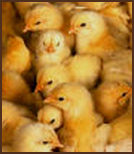For the first 4 or 5 days put the chicks on a "grippable" surface. Hardware cloth or burlap work well.
The "grippable" surface helps the chicks learn to walk and aids in preventing splayed legs, slipped tendons and other leg deformities. Once the chicks have a few days on this surface and have figured out what their food source is, spread some type of litter on the floor 2 to 4 inches deep. Wood shavings work well for this purpose and attention should be given to keeping the litter clean and dry.
Space Requirements: .5 sq ft per chick initially
.75 sq ft per chick at 6 weeks
1 sq ft per chick at 10 weeks
Raising chicks isn't difficult. Your first consideration will be where to keep them and this should be decided upon prior to getting your chicks. A brooder house can be anything from a cardboard box to an actual building depending on the size of your soon-to-be-acquired flock. The area should be kept clean, dry and draft free. Prepare your brooder before you bring the chicks home.
An infrared heat lamp will keep your chicks warm. (Red bulbs are preferable as they will cause less picking). Initially the temperature should be 95 degrees and lowered 5 degrees each week until 70 degrees is reached. At this point the heat can be removed unless the temperatures outside the brooder area are still quite cold. Position your lamp so that it will maintain the proper temperature, yet not pose a threat to igniting the litter or burning the chicks. The chicks are the best indicators of whether or not you are providing them with adequate heat. If they are all huddled together under the lamp you need to increase the heat in the brooder. Conversely, if they break off into little groups well outside the lamp, it's too hot. Ideally your chicks should be feeding and drinking and generally scattered about the brooder area.
Food and water will be your next concern. It's a good idea to dip the chicks beaks in their water and feed to initiate them to their food and water source. Waterers should "grow" with your birds. You will need an ample number of containers to accommodate the size of your flock. As the chicks grow their consumption increases and you will need to step up on the size of the waterer. Initially the chicks will need a small water fount of some type with marbles or small pebbles placed in it to keep them from swimming. Water is vital to the chicks existence, but being wet is not! The addition of vitamins and electrolytes to the chick's water will help them get off to a better start.
The same basics hold true for your feeders. The bigger the chicks get the larger feeder you will need. Your chicks can be fed Purina Start & Grow from hatch to lay (18-20 weeks). It can be fed as the sole ration for chicks and pullets used as replacement for egg production and is also great for mixed sex flocks. NEVER FEED SCRATCH TO CHICKS.
Often times people get a few chicks for their children to enjoy. Be advised that over-handling of the chicks can lead to a decrease in your chick population.
Raising chicks is not difficult. Remember to keep them warm, dry, fed and watered and before you know it you'll be the recipient of fresh eggs.
Control mites through the use of Permethrins. In warm weather, dip the rear of the bird in a solution of water and Permethrins. If the weather is cold dusting with Permethrins is recommended.
If your chicks show signs of rear end "pasting up" gently wash the area with a cloth or cotton ball dampened with warm water. As the chicks start to grow the "pasting" condition will disappear.


RAISING CHICKS - Requirements and care for newly hatched chickens
Do NOT feed fruit to layers. Fruit will stop them from laying and it may take as long as six weeks to bring them back into lay. A young flock of pullets that are about to come into lay and fed fruit will not come into lay for 4-6 weeks after the fruit is removed from their diet.
Chickens should be wormed at least twice a year. Piperazine is a good round worm medicine.
Poultry Links:
Web Site Design by S&J Enterprises - Homestead Website Design

